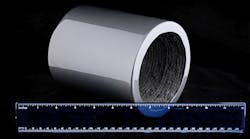In a paper published in Scientific Reports, scientists at Oak Ridge National Labs present 3D printed permanent isotropic magnets that use rare earth metals recycled from computer hard drives. The production methods have been non-exclusively licensed to Momentum Technologies for further development and imminent market proposals.
The research proposes a solution to lower the cost of manufacturing for high-strength magnets with custom designs suited for applications in motor vehicles, consumer electronics, wind turbines, and transportation with high-speed rails. At the same time, it provides a way to to source rare earth metals domestically, rather than relying on mining initiatives abroad.
“Old computers are obsolete so we have billions of hard disk drives that are available right now,” says Parans Paranthaman of ORNL. “We were looking for a domestic supply, and developing a method to substitute non-critical materials. Ninety percent of the critical material is imported from China so we are looking at recycling and remanufacturing the domestic material.”
The technique melts pellets that contain 65% NdFeB (neodymium magnet) and 35% nylon. ORNL uses its Big Area Additive Manufacturing (BAAM) machine to extrude the material using instructions from software. The solution replaces subtractive manufacturing that wastes expensive materials, and injection molding that require molds that can cost upward of 100,000 USD.
Director of the Critical Materials Institute, Alex King adds, “the ability to print high-strength magnets in complex shapes is a game changer for the design of efficient electric motors and generators. It removes many of the restrictions imposed by today’s manufacturing methods.”
The team announces plans to continue research for large-scale printing this summer. They will explore more bonding materials that blend magnetic powders with polymers to create magnets with complex magnetic-field geometries. Researching methods to 3D print these anisotropic magnets will present more potentials for real-world applications.
